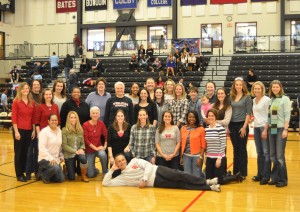I’ve recently had a series of talks with education officials, journalists and families about liberal arts education. There are international dimensions to these conversations that are exceptionally interesting to me, and I want to return to those in some future blog postings. Some of these discussions have concentrated on contrasts between a broad liberal arts education and a focused, technical study of STEM fields. This has struck me as odd because broad liberal learning also serves these fields so well. Today I am thinking about the ways in which the sciences are linked to the other liberal arts. In some contexts, people talk about the liberal arts and the sciences, as if biology and chemistry, physics and astronomy weren’t already part of the liberal arts. Even at Wesleyan there had been a tendency to make this two cultures mistake, which risks separating the sciences from our liberal arts mission. Regardless of which disciplines come to mind when we hear “liberal arts,” the fact is that almost all our science majors take classes in the social sciences, arts and humanities, and that there has been increasing interest among humanists, artists and social scientists in scientific research practices.
Many of our scientists have been interested in the intersection of their work with the broader community. Peter Patton, long-time faculty member in Earth and Environmental Sciences, recently led a field trip with students to study changes to some deep-rooted ecosystems in Puerto Rico. Last week biologist Janice Naegele spoke with a group of faculty from across the curriculum about her lab’s stem-cell work on brain seizures, and she also teaches classes that emphasize writing about science — translating research into clear terms for the generally educated reader. Suzanne O’Connell, a scientist now directing our Service Learning Center, has a similar concern about the dissemination of research. You can tune in to her “Science on the Radio” class. And there are plenty of other science faculty I could mention in this regard, as well as students who are helping to teach science to youngsters in Middletown.
Wesleyan’s Science in Society Program is at the heart of our efforts to maintain robust interconnections between the sciences and all the other fields on campus. For example, for many years philosopher Joe Rouse (who heads the program) has explored how scientific legitimacy is achieved, and how specific disciplinary practices in the sciences create modes of understanding. Laura Stark, a sociologist who also teaches in the SiSP program, has just published Behind Closed Doors: IRNs and the Making of Ethical Research. Laura’s work explores how institutional review boards come to approve some experiments and not others, and how their criteria for decision making reflects conceptions of what it means to be human and to have rights. In history, Bill Johnston, Paul Erickson and Jennifer Tucker all connect the sciences to their cultural contexts, as does Gillian Goslinga in anthropology. Jill Morawski, another member of SiSP and a psychologist who has been directing the Center for the Humanities, has been linking the topics at CHUM with issues in the sciences that intersect with philosophy, history, gender studies and ethics. Speaking of ethics, philosopher Lori Gruen’s work in animal studies has been very much influenced by her team teaching over the years with scientists. She has been at the forefront of the university’s curricular development in ethics.
Last year I joined the board of the Hastings Center, a non-partisan research institution dedicated to bioethics and the public interest. The president of the organization asked me to address the links between its mission in bioethics and the mission of universities and colleges dedicated to liberal arts education. The founders of the Hastings Center knew that science was too important to leave in the hands only of specialists, and over the years the staff has developed a robust research organization that connects advanced scientific work with ethical and policy issues. In a similar vein, I think it’s crucial that liberal arts colleges and universities ensure that higher education isn’t left in the hands only of specialists. We are connecting our schools to the worlds of public life, the economy and the broader culture. These connections will make for healthier and more successful scientific and educational institutions.
Here’s a link to my talk for Hastings:




